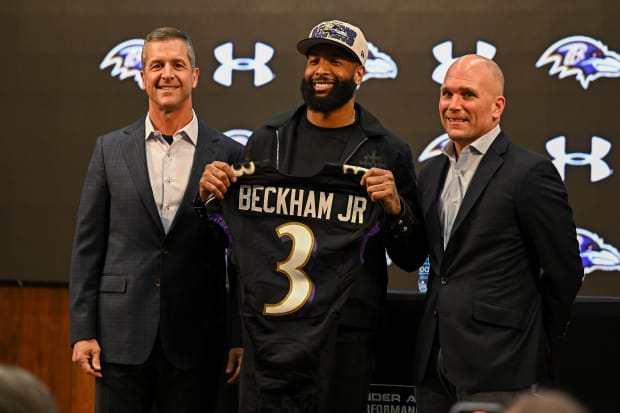After sending two teams to the playoffs last year, the AFC North could be even better this season.
While the Bengals and Ravens remain postseason favorites, the Browns are slated to get a full year of quarterback Deshaun Watson after he was suspended the first 11 games of 2022 due to upward of 20 allegations of sexual harassment and sexual assault. In Pittsburgh, the Steelers have Kenny Pickett under center for his second season and have surrounded him with better talent including receiver Allen Robinson II and first-round left tackler Broderick Jones.
So how does this quartet of playoff contenders stack up against one another? We rank the rosters from worst to best.
4. Pittsburgh Steelers
There’s a case for the Steelers to be higher on this list. Pittsburgh had one of the league’s stronger offseasons, adding corner Patrick Peterson, linebackers Cole Holcomb and Elandon Roberts, guard Isaac Seumalo and receiver Allen Robinson II via free agency or trade. In the draft, the Steelers nabbed the aforementioned Jones along with cornerback Joey Porter Jr. and tight end Darnell Washington, three players many felt were worthy of first-round selections.
However, there are still questions about this group. For starters, Kenny Pickett. As a rookie, Pickett showed flashes but not much more. He threw seven touchdowns against nine interceptions and only once in 12 starts averaged more than 7.0 yards per attempt.
While general manager Omar Khan did bring Robinson in to bolster the receiving corps, the veteran has been struggling the past two years. In 2021, Robinson caught 38 passes for 410 yards and one touchdown before signing a three-year deal with the Rams. He lasted one campaign in Los Angeles, totaling 33 receptions for 339 yards and three scores across 10 games before being dealt.
If the Steelers get a big leap from Pickett, they could take advantage of a favorable schedule, but it’s hard to rank Pittsburgh’s roster higher than fourth in this loaded division.
3. Cleveland Browns
The Browns are one of the biggest wild cards in the AFC. Are they going to get the performance they expected from quarterback Deshaun Watson when they traded for him last offseason, or will they get a similar return to the poor play from a year ago?
If Watson snaps back to his prior form, he’s surrounded by a talented offense. Cleveland has a premier running back in Nick Chubb and one of the league’s top offensive lines, anchored by tackle Jedrick Wills Jr. and guard Wyatt Teller. On the perimeter, receivers Amari Cooper and Donovan Peoples-Jones aren’t elite, but they’re good enough to cause problems.
Beyond Watson, the biggest question is what happens with the defense. Last year, the defense was middling once again, ranking 14th in yards against and 20th in points allowed. After adding defensive tackle Dalvin Tomlinson and replacing edge rusher Jadeveon Clowney with Ogbonnia Okoronkwo, Cleveland will be better up front.
Still, the linebackers remain a question mark, as does the secondary (save for corner Denzel Ward). The addition of safety Juan Thornhill will help with coverage and experience, but tackling and run support aren’t his strong suits.
2. Baltimore Ravens
The Ravens will look a bit different than the run-heavy, defensive teams of the past. Out is corner Marcus Peters, as well as edge rushers Jason Pierre-Paul and Justin Houston. In are receivers Odell Beckham Jr. and Zay Flowers, along with a new offensive coordinator in Todd Monken.

Reggie Hildred/USA TODAY Sports
While Baltimore is changing different parts of its roster and coaching staff, the team’s fortunes still come down to quarterback Lamar Jackson. Jackson, fresh off his five-year, $260 million extension, has new toys in Beckham and Flowers to pair with third-year receiver Rashod Bateman on the outside. Add in tight end Mark Andrews and running back J.K. Dobbins, and Baltimore is flush with weapons.
Defensively, the unit will revolve around corner Marlon Humphrey and All-Pro linebacker Roquan Smith. Baltimore will also hope to see improvements from youngsters like linebacker Patrick Queen and edge rusher Odafe Oweh; the former had his fifth-year option declined this offseason, while the latter is playing to secure one next year.
If things break right for Baltimore and Jackson stays healthy for the first time in three years, there’s reason to see the Ravens as a real contender. However, no team has more volatility in their 2023 outcome than Baltimore, with a multitude of unknowns remaining.
1. Cincinnati Bengals
The Bengals have earned this spot thanks to winning the last two AFC North crowns, and the fact that they did nothing this offseason to come off their perch.
Cincinnati lost a few notable pieces in safeties Vonn Bell and Jessie Bates III, but the Bengals backfilled nicely with 2022 first-round pick Dax Hill and free-agent signing Nick Scott. The Bengals also upgraded the offensive line while stealing from the Chiefs, landing left tackle Orlando Brown Jr. on a four-year pact. With Brown there, Cincinnati is sliding Jonah Williams to the right side, giving them a known presence while veteran La’el Collins recovers from a late-season torn ACL.
Looking at the Bengals, where are the weaknesses? Corner isn’t great, with Chidobe Awuzie coming off a knee injury and Eli Apple remaining an annual liability, but linebackers Germaine Pratt and Logan Wilson are excellent. Plus, the front four is loaded with Sam Hubbard, Trey Hendrickson and first-round rookie Myles Murphy.
Offensively, quarterback Joe Burrow is an MVP candidate, while Ja’Marr Chase, Tee Higgins and Tyler Boyd are the league’s top trio of receivers. Cincinnati figures to be dominant once more and will likely be the top challenger to Kansas City in what is a loaded AFC.














